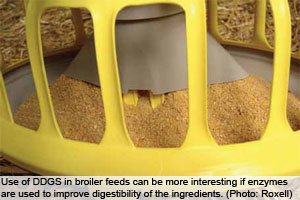Enzyme technology boosts performance of DDGS

With feed prices so high, now, more than ever, pig and poultry producers need to exploit technologies available to them to maximise margins. Using enzyme technology they have the opportunity to reformulate diets with lower energy, phosphorus and calcium levels and also include some DDGS in their formulations to further reduce feed costs.
The use of distillers dried grains with solubles (DDGS) in animal feed has increased with the growth of the bioethanol industry. Whilst corn DDGS are a potential good source of protein, vitamins and minerals as they contain around three times more non-starch nutrients than corn they are also highly fibrous (Table 1). Pig and poultry producers looking to reduce feed costs can consider using feed ingredients, such as DDGS, to stay ahead of tightening economic pressures. However, whilst DDGS is potentially a cost effective and valuable feed ingredient, there are certain anti-nutritional factors which limit its use in pig and poultry feed.
Insoluble fibres contained in DDGS hold water creating more bulk in the animal’s gut, which can reduce feed intake and subsequent growth. These fibres also bind water-soluble nutrients and enclose them, so they are less available for digestion.
DDGS typically contain 0.38-1.53% phytate. Phytate is the principal storage form of phosphorus in many feed ingredients of plant origin. Most of the phosphorus contained within phytate is in a form which cannot be readily digested by pig and poultry. In addition, phytate binds nutrients such as calcium, energy and amino acids. These bound nutrients are resistant to digestion and unavailable to the animal. Consistency can also be a big problem as the nutrient composition of DDGS can vary from batch to batch and plant to plant. Flowability of the product is another challenge during storage in the feed mill.
Enzyme solutions
Enzymes are widely used in pig and poultry feed today. However, their use in overcoming the nutritional challenges associated with feeding DDGS is relatively new. Broiler producers looking for lower feed costs with DDGS supplemented with enzymes can save around $12/tonne, without risking bird performance, according to the latest research from Danisco Animal Nutrition. Two trials conducted by Auburn University and Purdue University, USA, showed that adding both a new- generation phytase (Phyzyme® XP) together with xylanase, amylase and protease enzymes (Avizyme® 1502) to corn soy broiler diets containing 10% corn DDGS improved bodyweight gain and feed efficiency (Figure 1). Bodyweight gain was improved by around 5-8% and feed conversion improved by up to 11 points (6%). In the Auburn University trial, the enzyme combination was also added to a lower cost diet reduced in energy by 80 kcal/kg feed and containing 0.1% lower available phosphorus and lower calcium. At 56 days of age, broiler live weight gain was significantly better (8%) and feed conversion numerically improved (4 points) compared to broilers fed a standard corn soy diet containing 10% corn DDGS.
A trial conducted by the University of Illinois, USA, showed that adding both the new-generation phytase together with a highly effective xylanase (Porzyme® 9300) to a corn-soy pig diet containing 20% corn DDGS significantly improved digestible energy by 5.6% (175 kcal/kg), ileal amino acid digestibility by around 4.5% and increased phosphorus digestibility from 22% to 51% (Table 2). The enzyme combinations help breakdown some of the anti-nutrients in diets containing corn and corn DDGS.
With feed prices so high, now, more than ever, pig and poultry producers need to exploit technologies available to them to maximise margins. Trials showed improved weight gain and lower feed conversion rates when using the enzyme technology to reformulate the diets with lower energy, phosphorus and calcium levels and also include some DDGS in their formulations to further reduce feed costs. For example, in the trial conducted at Auburn University, gross feed cost savings of over $12/tonne were achieved.











